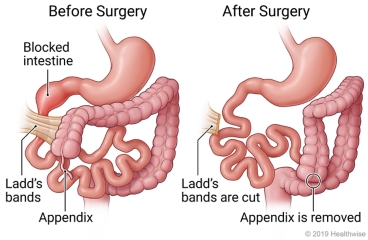What is it?
A Ladd procedure is a type of surgery. It fixes a problem with how your baby's intestines are positioned in the belly.
Why is it done?
A Ladd procedure may be needed if the position of your baby's intestines causes problems.
Before a baby is born, the intestines turn inside the body as they grow. In most cases, this turning continues until the intestines end up where they should be inside the belly. But if they start to turn and don't finish, they won't be in the right position. This is called malrotation.
If your baby has a malrotation, the intestine can twist and become blocked. If it isn't untwisted right away, that part of the intestine can die and must be removed.
Sometimes bands of tissue (Ladd's bands) can grow and press on the intestine, also causing a blockage.
How is it done?
The doctor will make a cut (incision) in your baby's belly. The doctor might make a few very small cuts to use a camera to see during the surgery.
If your baby's intestine is twisted, the doctor will untwist it. Then the doctor will cut the bands of tissue that are pressing on the intestine. The doctor will make sure that the intestine looks healthy.
The doctor will move the intestine into a better position in the belly. The doctor will also remove your baby's appendix. This helps prevent problems with it in the future.
Your baby will be watched closely after the surgery. The care team will look for any changes in health that need more treatment.
What can you expect afterward?
Babies recover at different speeds. How long it will take depends on what symptoms your baby had before the surgery. It also depends on how healthy the intestine is. Your baby may need to stay in the hospital for at least a few days.
Your baby will get pain medicine after the surgery. Your baby will be watched closely. The care team will make sure that your baby's bowels are working as they should.
When it's time to go home, the doctor will give you instructions. They will include things like how to care for your baby's incision and what medicines your baby needs. You'll also get instructions on how to feed your baby during recovery.
Follow-up care is a key part of your child's treatment and safety. Be sure to make and go to all appointments, and call your doctor if your child is having problems. It's also a good idea to know your child's test results and keep a list of the medicines your child takes.


